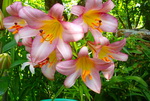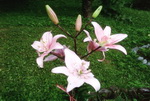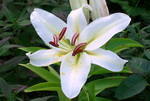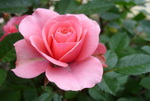|
  
  
Although found all over the world, roses grow best in mild climates, such as southern France and the U.S. Pacific coast. Roses excellent growth in many different kinds of soil and climate is a result of the availability of myriad cultivars. A rose garden should be protected from cold wind and be exposed to sunlight for several hours a day. Deep, rich loam is best for roses, but most cultivars grow in sandy and gravelly soil. The soil must be well drained. Roses are planted in spring, about 2 feet (0.6 meter) apart. In the United States, about sixty-five million commercial rose plants are cultivated yearly. About 35 percent are grown for cut flowers, and the rest are used in gardens or landscaping. For the best growth, rose plants require severe pruning, which is adapted to the intended use of the flowers. Most varieties are grown by budding on understocks. Roses are susceptible to diseases such as rust and black-spot disease, so pests should be watched for and discouraged.
Lilies grow best in well-drained, deep, sandy loam, sheltered from winds and hot sunlight. Their bulbs are planted 6 or more inches (15 or more centimeters) underground, in late fall. This deep placement is used because they send out their roots well above the bulbs. As soon as blooms wilt, their seed pods should be removed. Lilies can be made to bloom early by putting the bulbs in pots and covering them with peat moss or soil. When kept at 50 degrees Fahrenheit for two weeks and then stored at 60 degrees Fahrenheit, they bloom in three months. Lilies are susceptible to a number of diseases. The most serious is mosaic, carried from plant to plant by aphids. Infected plants should be uprooted at once and burned to prevent an epidemic. A second severe disease of lilies is botrytis blight.
|
